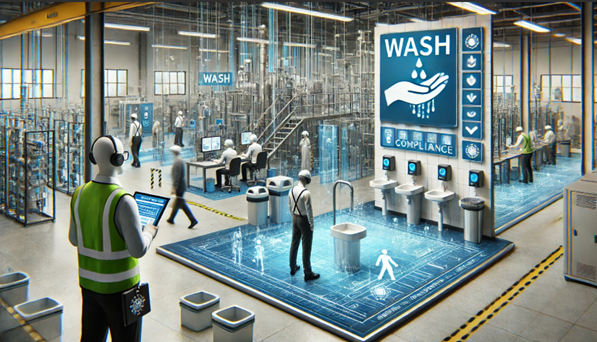
Why WASH Compliance is the Next Big Thing in Workplace Safety
Workplace safety is evolving beyond traditional measures like fire safety, PPE, and accident prevention. In today’s world, Water, Sanitation, and Hygiene (WASH) compliance is becoming a critical component of workplace safety and employee well-being.
With increasing concerns over public health, disease prevention, and hygiene standards, businesses must ensure that their facilities meet WASH guidelines to protect employees, customers, and stakeholders.
But why is WASH compliance the next big thing in workplace safety? Let’s explore its growing importance, key benefits, and how businesses can implement WASH standards effectively.
1. What is WASH Compliance?
WASH stands for Water, Sanitation, and Hygiene—a framework designed to ensure clean water supply, proper sanitation, and hygiene practices in workplaces, schools, healthcare facilities, and communities.
WASH compliance includes:
✅ Safe drinking water availability
✅ Proper sanitation and waste disposal
✅ Hygiene facilities like handwashing stations
✅ Clean and well-maintained restrooms
✅ Disease prevention measures (e.g., COVID-19 protocols, air quality checks)
The World Health Organization (WHO) and ISO 24521 set global standards for WASH compliance, ensuring organizations provide a healthy and safe environment for workers and visitors.
2. Why WASH Compliance is Critical for Workplace Safety
a) Preventing Workplace Illnesses & Infections
Poor hygiene and sanitation lead to increased cases of waterborne diseases, respiratory infections, and workplace illnesses. Ensuring clean drinking water, sanitation, and proper hand hygiene can prevent common illnesses like:
🔹 Diarrhea and foodborne infections
🔹 Respiratory illnesses (COVID-19, flu)
🔹 Skin infections from unclean surfaces
🔹 Occupational exposure to hazardous chemicals in water
Implementing WASH compliance reduces employee absenteeism and improves productivity.
b) Meeting Legal & Regulatory Requirements
Governments worldwide are enforcing stricter hygiene and sanitation regulations in workplaces. Non-compliance can lead to:
🚨 Fines and penalties for businesses failing to meet hygiene standards
🚨 Legal liabilities in case of workplace-related health incidents
🚨 Loss of operating licenses in industries like food, healthcare, and manufacturing
By adopting ISO 24521 (WASH in workplaces) and WHO’s hygiene standards, businesses can ensure full regulatory compliance.
c) Enhancing Employee Health & Productivity
A clean and hygienic work environment leads to:
✔ Fewer sick days and absenteeism
✔ Higher employee morale and job satisfaction
✔ Improved focus, efficiency, and productivity
Studies show that companies with proper WASH facilities experience higher employee engagement and better workplace performance.
d) Strengthening Brand Reputation & Customer Trust
Businesses that prioritize WASH compliance:
✅ Attract more customers, employees, and investors
✅ Enhance their corporate social responsibility (CSR) profile
✅ Build trust and credibility in industries where hygiene matters (e.g., hospitality, healthcare, manufacturing)
Consumers and employees are increasingly choosing brands that care about health, hygiene, and sustainability.
e) Sustainability & Environmental Responsibility
WASH compliance also supports environmental sustainability by:
🌱 Reducing water waste through efficient water management
🌱 Implementing eco-friendly sanitation systems
🌱 Ensuring proper disposal of hazardous waste
Companies that adopt green WASH practices align with global sustainability goals (SDG 6: Clean Water & Sanitation).
3. How Businesses Can Implement WASH Compliance
Step 1: Assess Current WASH Standards
🔍 Conduct a workplace hygiene audit
🔍 Identify gaps in water supply, sanitation, and hygiene practices
Step 2: Upgrade Hygiene Facilities
🚰 Install clean drinking water stations
🧼 Provide soap, sanitizers, and handwashing facilities
🚽 Maintain clean and safe restrooms with proper waste disposal
Step 3: Develop WASH Policies & Training
📌 Establish clear hygiene policies for employees and visitors
📌 Train staff on proper hygiene, sanitation, and health protocols
Step 4: Monitor & Ensure Compliance
✅ Conduct regular hygiene inspections
✅ Use smart water management systems to track water usage and quality
✅ Encourage continuous improvement in WASH practices
4. The Future of Workplace Safety with WASH Compliance
As global health challenges continue to rise, WASH compliance will become a standard requirement for businesses. Future trends include:
🚀 Smart Hygiene Monitoring – AI-powered systems tracking hygiene compliance in real time
🚀 Sustainable Water Management – Recycling wastewater and reducing consumption
🚀 Touchless Hygiene Solutions – Sensor-based soap dispensers and self-cleaning restrooms
Businesses that embrace WASH compliance early will stay ahead of regulations, protect their workforce, and enhance brand reputation.
5. Conclusion: WASH Compliance is the Future of Workplace Safety
In 2024 and beyond, WASH compliance will be as essential as fire safety and PPE regulations. Companies that prioritize water, sanitation, and hygiene will not only improve employee health and productivity but also enhance sustainability, meet legal requirements, and gain a competitive edge.
💡 Is your workplace WASH-compliant? Start implementing hygiene best practices today to create a safer, healthier, and more sustainable work environment. 🚰🧼♻️
👉 Need help with WASH compliance? Contact us today for expert guidance! ✅